ad blue CHEVROLET EXPRESS CARGO VAN 2000 1.G Owners Manual
[x] Cancel search | Manufacturer: CHEVROLET, Model Year: 2000, Model line: EXPRESS CARGO VAN, Model: CHEVROLET EXPRESS CARGO VAN 2000 1.GPages: 398, PDF Size: 2.69 MB
Page 7 of 398
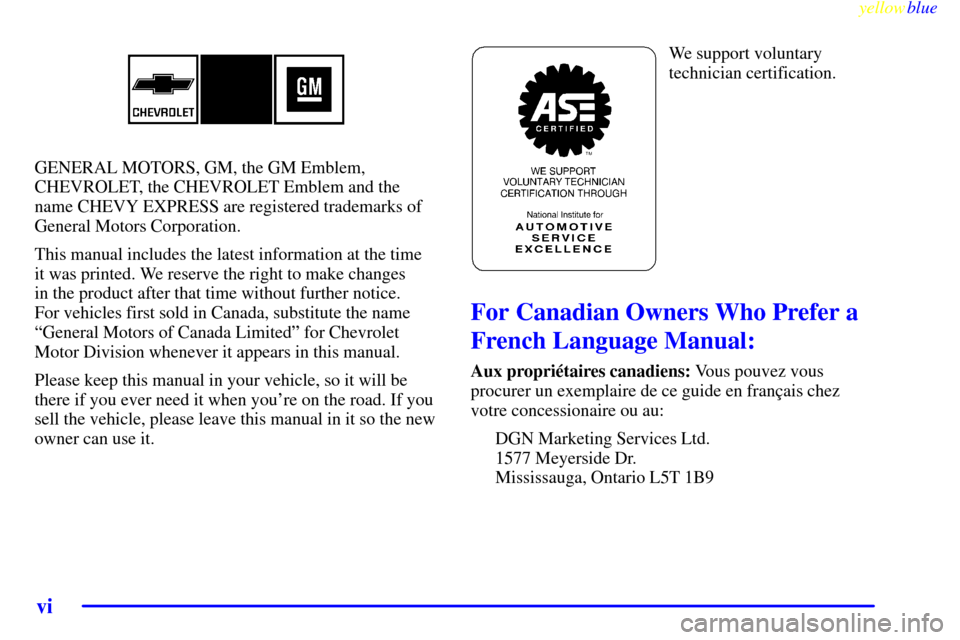
yellowblue
vi
GENERAL MOTORS, GM, the GM Emblem,
CHEVROLET, the CHEVROLET Emblem and the
name CHEVY EXPRESS are registered trademarks of
General Motors Corporation.
This manual includes the latest information at the time
it was printed. We reserve the right to make changes
in the product after that time without further notice.
For vehicles first sold in Canada, substitute the name
ªGeneral Motors of Canada Limitedº for Chevrolet
Motor Division whenever it appears in this manual.
Please keep this manual in your vehicle, so it will be
there if you ever need it when you're on the road. If you
sell the vehicle, please leave this manual in it so the new
owner can use it.
We support voluntary
technician certification.
For Canadian Owners Who Prefer a
French Language Manual:
Aux propri‡taires canadiens: Vous pouvez vous
procurer un exemplaire de ce guide en fran†ais chez
votre concessionaire ou au:
DGN Marketing Services Ltd.
1577 Meyerside Dr.
Mississauga, Ontario L5T 1B9
Page 8 of 398
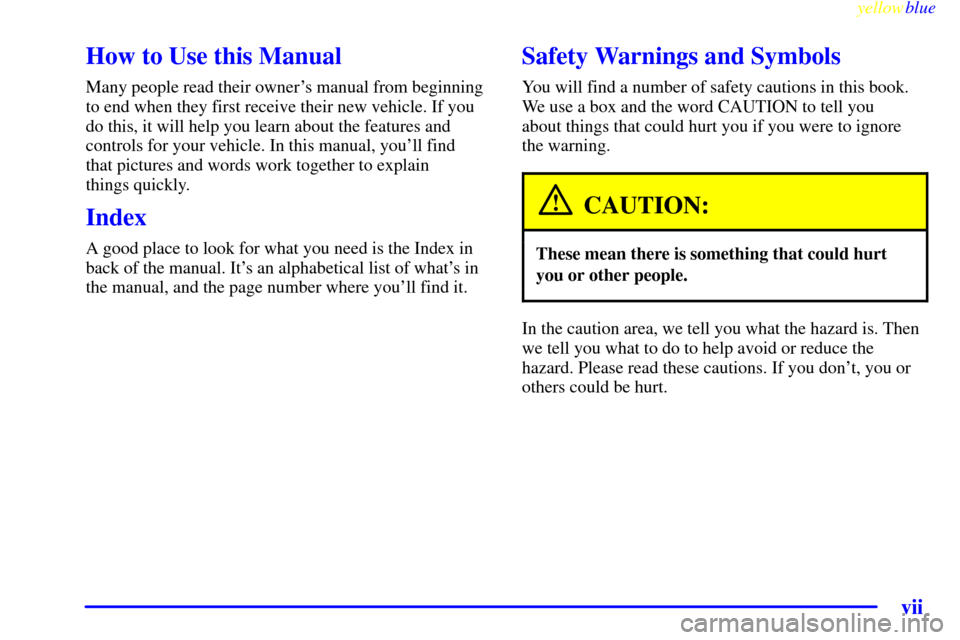
yellowblue
vii
How to Use this Manual
Many people read their owner's manual from beginning
to end when they first receive their new vehicle. If you
do this, it will help you learn about the features and
controls for your vehicle. In this manual, you'll find
that pictures and words work together to explain
things quickly.
Index
A good place to look for what you need is the Index in
back of the manual. It's an alphabetical list of what's in
the manual, and the page number where you'll find it.
Safety Warnings and Symbols
You will find a number of safety cautions in this book.
We use a box and the word CAUTION to tell you
about things that could hurt you if you were to ignore
the warning.
CAUTION:
These mean there is something that could hurt
you or other people.
In the caution area, we tell you what the hazard is. Then
we tell you what to do to help avoid or reduce the
hazard. Please read these cautions. If you don't, you or
others could be hurt.
Page 9 of 398
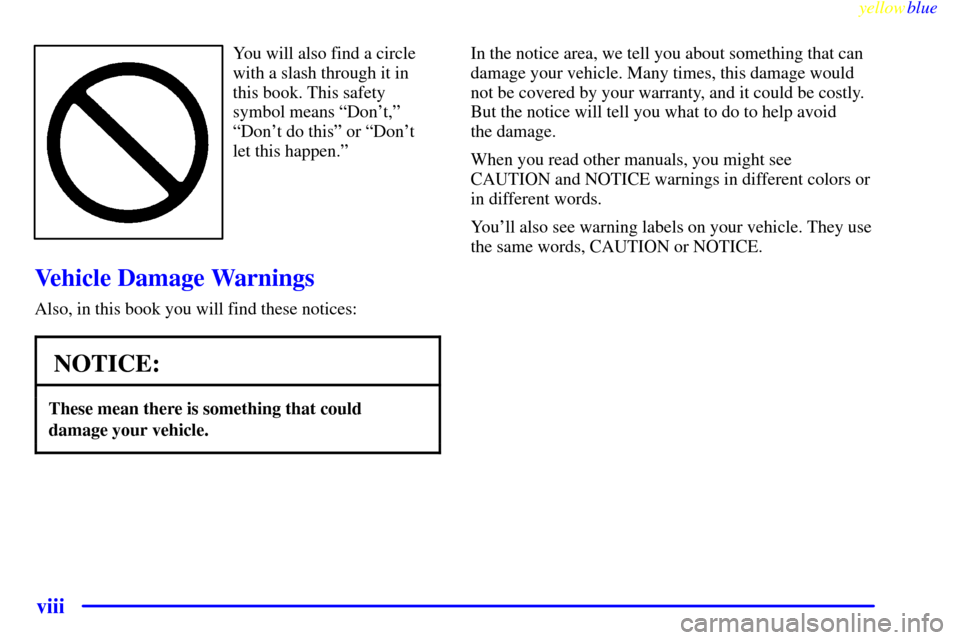
yellowblue
viii
You will also find a circle
with a slash through it in
this book. This safety
symbol means ªDon't,º
ªDon't do thisº or ªDon't
let this happen.º
Vehicle Damage Warnings
Also, in this book you will find these notices:
NOTICE:
These mean there is something that could
damage your vehicle.
In the notice area, we tell you about something that can
damage your vehicle. Many times, this damage would
not be covered by your warranty, and it could be costly.
But the notice will tell you what to do to help avoid
the damage.
When you read other manuals, you might see
CAUTION and NOTICE warnings in different colors or
in different words.
You'll also see warning labels on your vehicle. They use
the same words, CAUTION or NOTICE.
Page 10 of 398
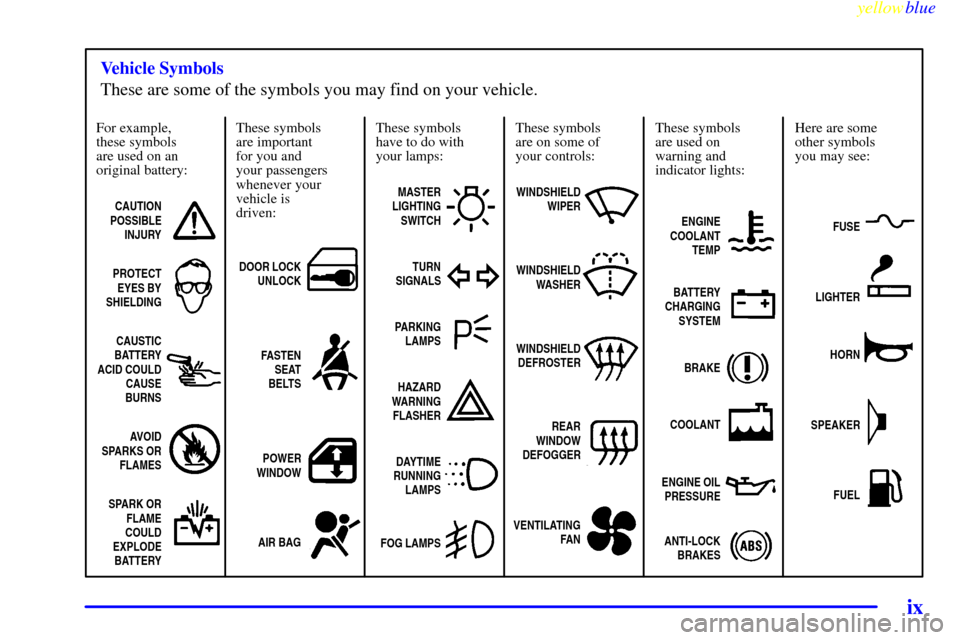
yellowblue
ix
For example,
these symbols
are used on an
original battery:
CAUTION
POSSIBLE
INJURY
PROTECT
EYES BY
SHIELDING
CAUSTIC
BATTERY
ACID COULD
CAUSE
BURNS
AVOID
SPARKS OR
FLAMES
SPARK OR
FLAME
COULD
EXPLODE
BATTERY
These symbols
are important
for you and
your passengers
whenever your
vehicle is
driven:
DOOR LOCK
UNLOCK
FASTEN
SEAT
BELTS
POWER
WINDOW
AIR BAG
These symbols
have to do with
your lamps:
MASTER
LIGHTING
SWITCH
TURN
SIGNALS
PARKING
LAMPS
HAZARD
WARNING
FLASHER
DAYTIME
RUNNING
LAMPS
FOG LAMPS
These symbols
are on some of
your controls:
WINDSHIELD
WIPER
WINDSHIELD
WASHER
WINDSHIELD
DEFROSTER
REAR
WINDOW
DEFOGGER
VENTILATING
FAN
These symbols
are used on
warning and
indicator lights:
ENGINE
COOLANT
TEMP
BATTERY
CHARGING
SYSTEM
BRAKE
COOLANT
ENGINE OIL
PRESSURE
ANTI-LOCK
BRAKES
Here are some
other symbols
you may see:
FUSE
LIGHTER
HORN
SPEAKER
FUEL
Vehicle Symbols
These are some of the symbols you may find on your vehicle.
Page 11 of 398
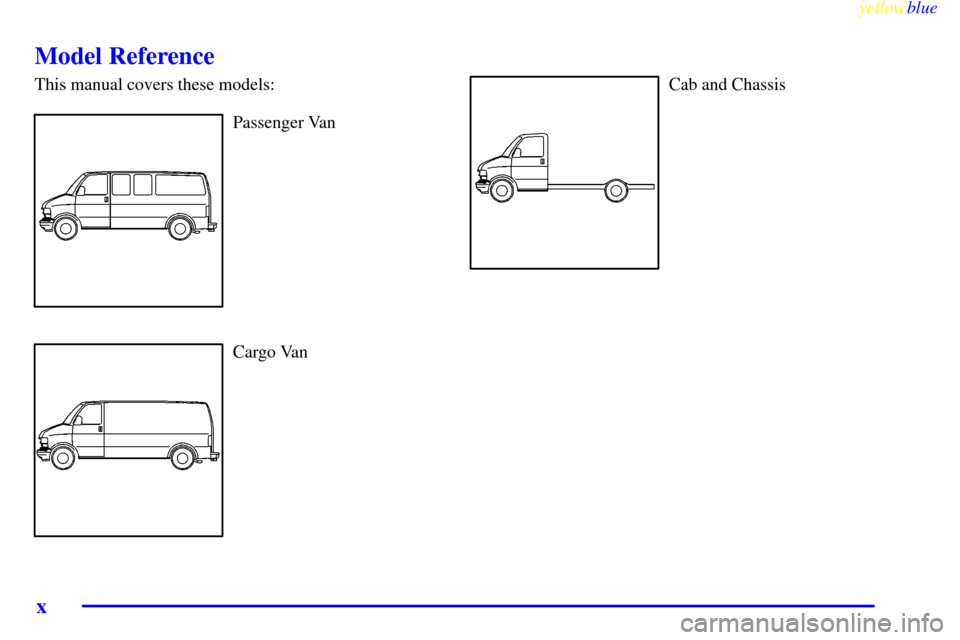
yellowblue
x
Model Reference
This manual covers these models:
Passenger Van
Cargo Van
Cab and Chassis
Page 13 of 398
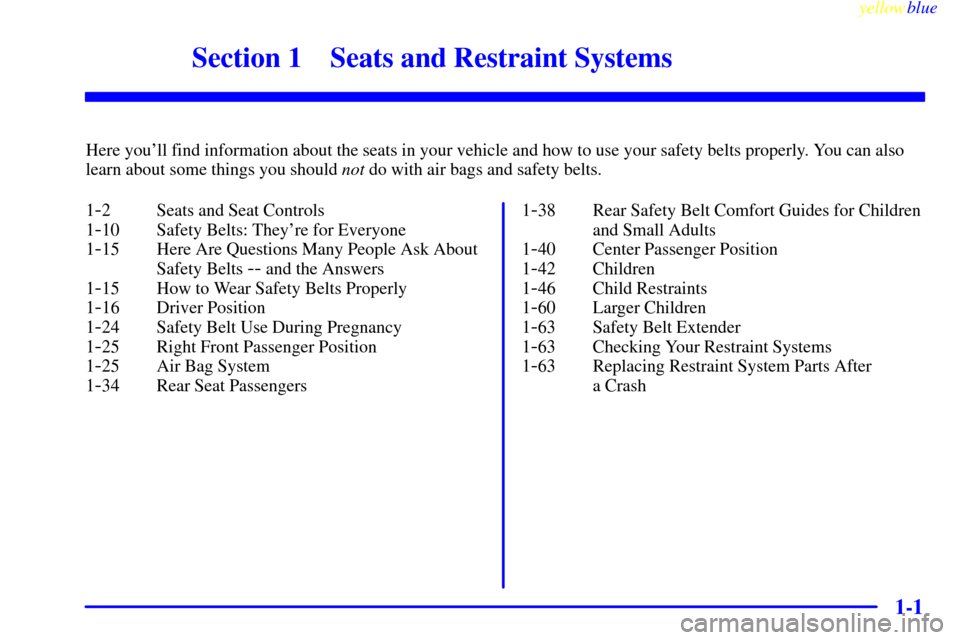
1-
yellowblue
1-1
Section 1 Seats and Restraint Systems
Here you'll find information about the seats in your vehicle and how to use your safety belts properly. You can also
learn about some things you should not do with air bags and safety belts.
1
-2 Seats and Seat Controls
1
-10 Safety Belts: They're for Everyone
1
-15 Here Are Questions Many People Ask About
Safety Belts
-- and the Answers
1
-15 How to Wear Safety Belts Properly
1
-16 Driver Position
1
-24 Safety Belt Use During Pregnancy
1
-25 Right Front Passenger Position
1
-25 Air Bag System
1
-34 Rear Seat Passengers1
-38 Rear Safety Belt Comfort Guides for Children
and Small Adults
1
-40 Center Passenger Position
1
-42 Children
1
-46 Child Restraints
1
-60 Larger Children
1
-63 Safety Belt Extender
1
-63 Checking Your Restraint Systems
1
-63 Replacing Restraint System Parts After
a Crash
Page 14 of 398
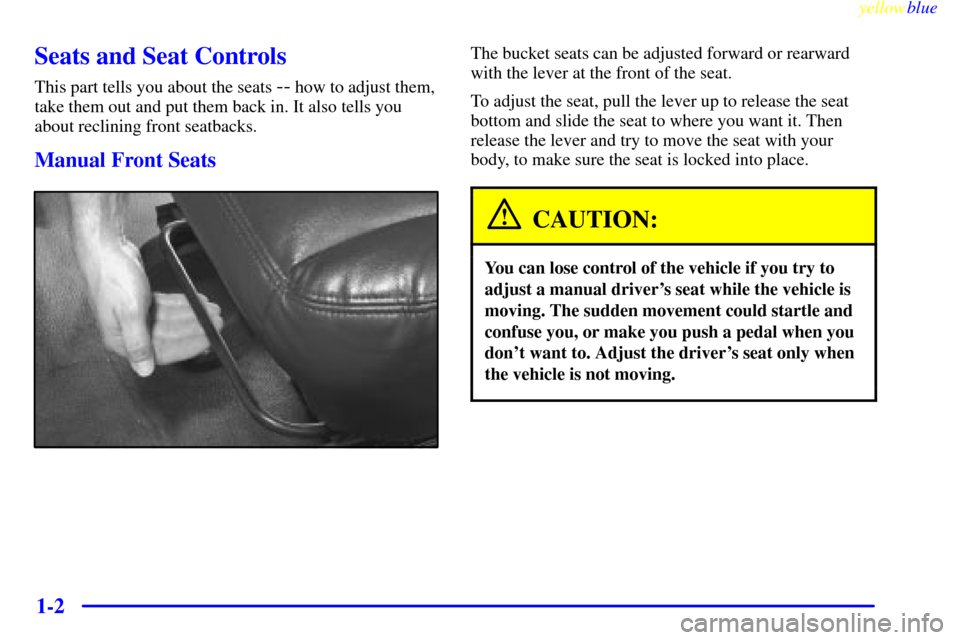
yellowblue
1-2
Seats and Seat Controls
This part tells you about the seats -- how to adjust them,
take them out and put them back in. It also tells you
about reclining front seatbacks.
Manual Front Seats
The bucket seats can be adjusted forward or rearward
with the lever at the front of the seat.
To adjust the seat, pull the lever up to release the seat
bottom and slide the seat to where you want it. Then
release the lever and try to move the seat with your
body, to make sure the seat is locked into place.
CAUTION:
You can lose control of the vehicle if you try to
adjust a manual driver's seat while the vehicle is
moving. The sudden movement could startle and
confuse you, or make you push a pedal when you
don't want to. Adjust the driver's seat only when
the vehicle is not moving.
Page 15 of 398
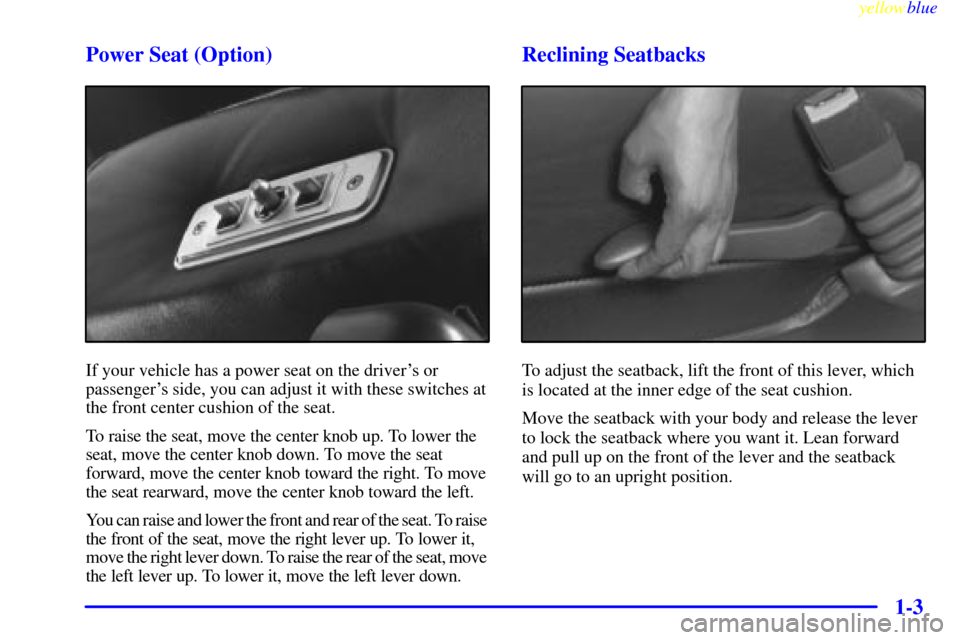
yellowblue
1-3 Power Seat (Option)
If your vehicle has a power seat on the driver's or
passenger's side, you can adjust it with these switches at
the front center cushion of the seat.
To raise the seat, move the center knob up. To lower the
seat, move the center knob down. To move the seat
forward, move the center knob toward the right. To move
the seat rearward, move the center knob toward the left.
You can raise and lower the front and rear of the seat. To raise
the front of the seat, move the right lever up. To lower it,
move the right lever down. To raise the rear of the seat, move
the left lever up. To lower it, move the left lever down.
Reclining Seatbacks
To adjust the seatback, lift the front of this lever, which
is located at the inner edge of the seat cushion.
Move the seatback with your body and release the lever
to lock the seatback where you want it. Lean forward
and pull up on the front of the lever and the seatback
will go to an upright position.
Page 16 of 398
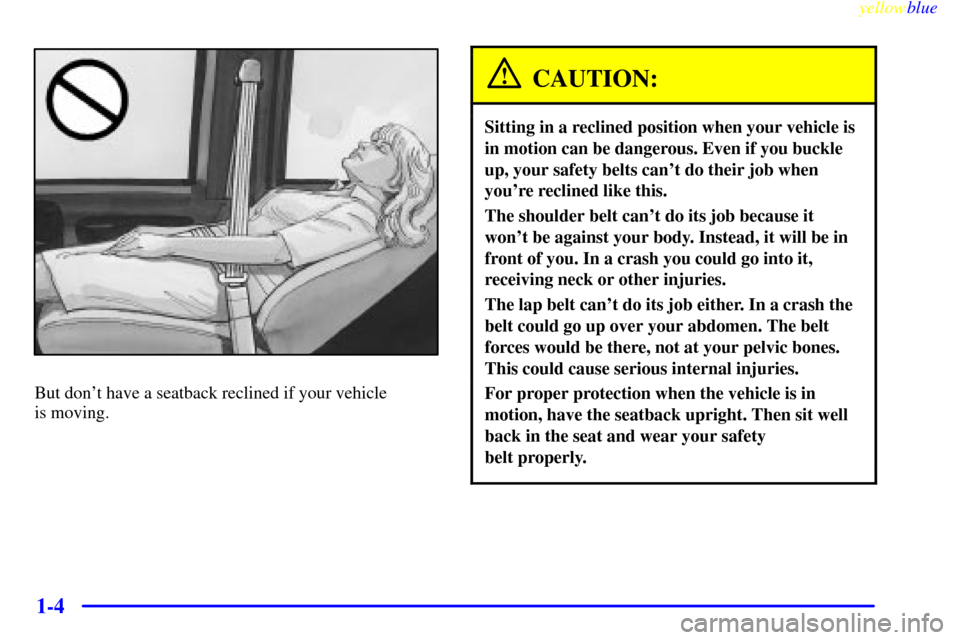
yellowblue
1-4
But don't have a seatback reclined if your vehicle
is moving.
CAUTION:
Sitting in a reclined position when your vehicle is
in motion can be dangerous. Even if you buckle
up, your safety belts can't do their job when
you're reclined like this.
The shoulder belt can't do its job because it
won't be against your body. Instead, it will be in
front of you. In a crash you could go into it,
receiving neck or other injuries.
The lap belt can't do its job either. In a crash the
belt could go up over your abdomen. The belt
forces would be there, not at your pelvic bones.
This could cause serious internal injuries.
For proper protection when the vehicle is in
motion, have the seatback upright. Then sit well
back in the seat and wear your safety
belt properly.
Page 17 of 398
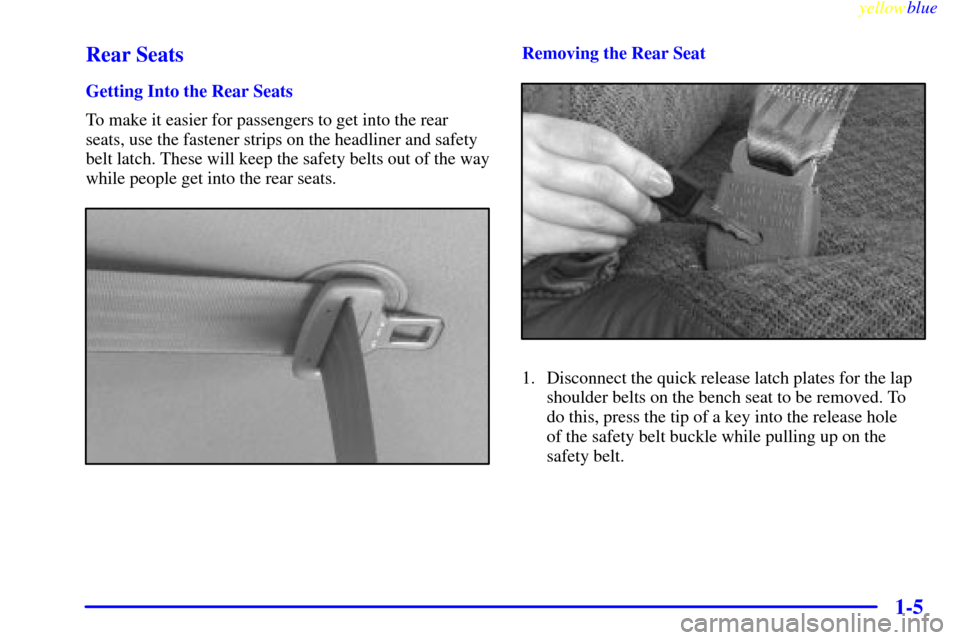
yellowblue
1-5 Rear Seats
Getting Into the Rear Seats
To make it easier for passengers to get into the rear
seats, use the fastener strips on the headliner and safety
belt latch. These will keep the safety belts out of the way
while people get into the rear seats.
Removing the Rear Seat
1. Disconnect the quick release latch plates for the lap
shoulder belts on the bench seat to be removed. To
do this, press the tip of a key into the release hole
of the safety belt buckle while pulling up on the
safety belt.